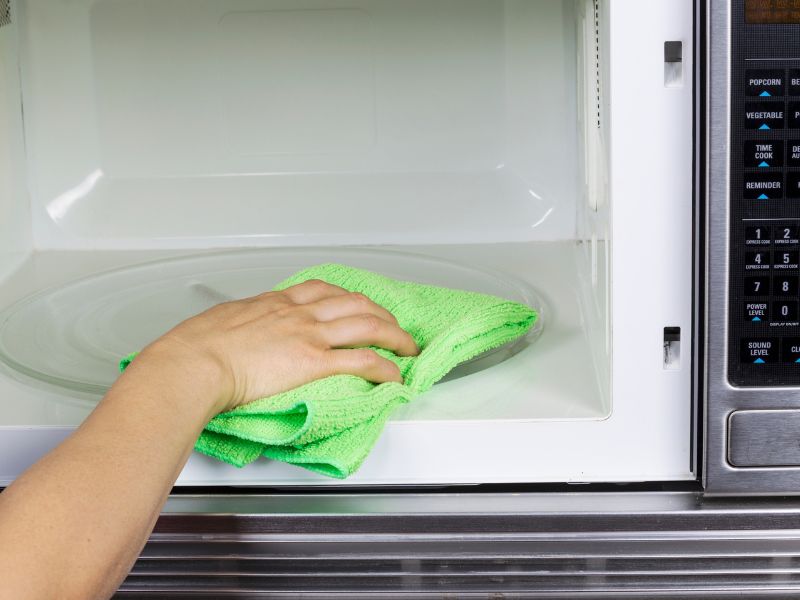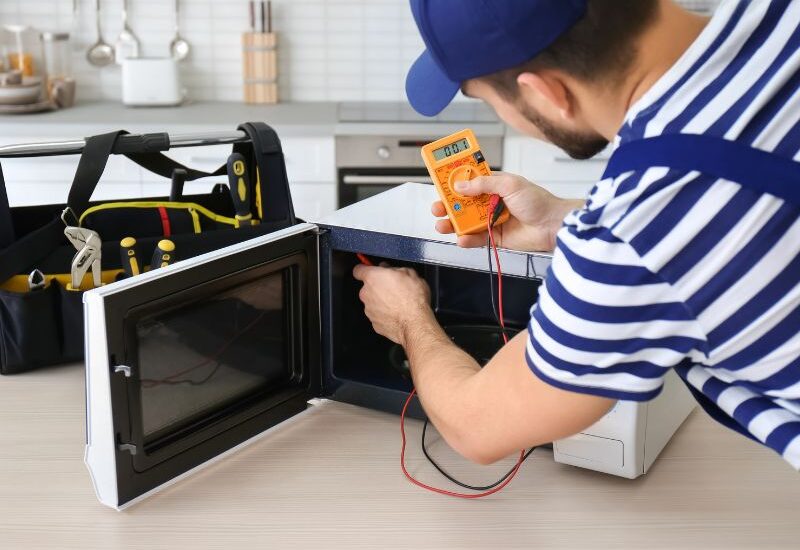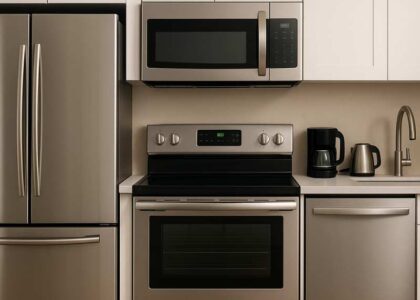In today’s modern kitchen, the microwave oven has revolutionized meal preparation, offering convenience and efficiency like never before. From quickly reheating leftovers to cooking full meals in minutes, the microwave has become an indispensable appliance. However, to ensure that your microwave continues to serve you well for years to come, regular maintenance is essential. In this guide, we’ll delve into the importance of microwave oven maintenance and provide practical tips to help you maintain its longevity and efficiency.
Importance of Microwave Oven Maintenance
Microwave oven maintenance is not just about keeping your appliance looking clean—it’s crucial for its performance, longevity, and safety. Here’s why it’s important to prioritize microwave maintenance:
Efficient Cooking: A well-maintained microwave oven cooks food more evenly and quickly. Regular cleaning prevents food splatters and grease buildup that can affect heating patterns, ensuring consistent cooking results.
Extended Lifespan: Proper maintenance significantly extends the lifespan of your microwave. Routine cleaning and inspections help identify potential issues early, preventing major breakdowns and costly repairs down the line.
Safety First: Neglected microwaves can harbor bacteria and food debris, leading to odors and potential health hazards. Regular maintenance helps keep your microwave clean and safe for food preparation.
Energy Efficiency: A clean and well-maintained microwave is more energy-efficient. When food residues absorb microwave energy, it reduces the appliance’s efficiency and requires more power to achieve the desired cooking results.
Why Proper Maintenance is Essential
Proper maintenance of your microwave oven is crucial for ensuring its longevity, efficiency, and safety. Here’s why you should prioritize regular maintenance:
- Prevents Breakdowns: Routine maintenance allows you to identify and address potential issues before they escalate into major problems. By inspecting your microwave regularly, you can catch minor issues such as worn-out seals or malfunctioning components and take corrective action before they cause a breakdown.
- Maintains Performance: A well-maintained microwave operates more efficiently. Cleaning the interior regularly prevents food splatters and grease buildup, which can affect heating patterns and cooking performance. When your microwave functions optimally, you can rely on it to heat food evenly and quickly.
- Ensures Safety: Neglected microwaves can pose safety hazards. Built-up food residues or grease inside the microwave can lead to odors, smoke, or even fires during operation. Proper maintenance, including cleaning and inspection of components like the door seal, ensures that your microwave remains safe to use.
- Preserves Longevity: Regular maintenance significantly extends the lifespan of your microwave oven. By taking care of your appliance and addressing any issues promptly, you reduce the risk of premature wear and tear, ultimately prolonging its useful life.
- Cost Savings: Investing time in maintenance now can save you money in the long run. Preventative maintenance helps avoid expensive repairs or the need for premature replacement of the microwave. By keeping your microwave in good condition, you minimize the likelihood of unexpected breakdowns and associated repair costs.
Cleaning Your Microwave

Regular cleaning of your microwave oven is essential to ensure efficient operation and maintain a clean and hygienic cooking environment. Follow these steps to effectively clean your microwave:
Daily Wipe-Down: After each use, quickly wipe down the interior surfaces of the microwave with a damp cloth or sponge to remove any food splatters, spills, or residues. Pay special attention to areas with visible stains or grease buildup.
Steam Cleaning Method: For stubborn stains or lingering odors, use a steam cleaning method:
- Place a microwave-safe bowl filled with water and a few tablespoons of white vinegar inside the microwave.
- Heat the mixture on high power for 3-5 minutes until it produces steam. The steam will help loosen food residues and grease.
- Keep the microwave door closed for a few more minutes to allow the steam to soften the stains.
- Carefully remove the bowl (it will be hot) and wipe down the interior surfaces with a damp cloth or sponge. Stubborn stains should now be easier to remove.
Cleaning the Turntable and Tray: Remove the turntable and any removable tray or rack from the microwave.
- Wash them in warm, soapy water using a sponge or dishcloth.
- For tough stains, let the turntable soak in warm, soapy water for a few minutes before scrubbing.
- Dry the turntable and tray thoroughly with a clean towel before placing them back into the microwave.
Exterior Maintenance: Don’t forget to clean the exterior of the microwave:
- Wipe down the exterior surfaces, including the door, control panel, and handle, with a damp cloth to remove dust, fingerprints, and spills.
- Use a mild cleaning solution or all-purpose cleaner if needed, but avoid abrasive cleaners that could damage the surface.
Regular Maintenance Schedule: Establish a regular cleaning schedule for your microwave oven based on usage frequency. For example, if you use your microwave daily, plan to perform a thorough cleaning at least once a week.
Troubleshooting Common Problems
While microwave ovens are generally reliable appliances, they can encounter issues from time to time. Knowing how to troubleshoot common problems can help you identify and resolve issues quickly. Here are some common microwave problems and steps to troubleshoot them:
Microwave Not Heating Properly:
- Check if the microwave is plugged in properly and receiving power. Ensure that the circuit breaker or fuse hasn’t tripped.
- Verify that the door is fully closed and the door seal (gasket) is intact. An open or faulty door can prevent the microwave from heating.
- If the microwave still doesn’t heat, it could be a problem with the magnetron, which may require professional repair or replacement.
Unusual Noises During Operation:
- If your microwave is making unusual noises like buzzing, humming, or clicking, it may indicate issues with the internal components.
- Turn off and unplug the microwave, then inspect the turntable and rotating mechanism for any obstructions or signs of damage.
- If the problem persists, there may be a problem with the motor or other internal components, requiring professional diagnosis and repair.
Display Errors or Error Codes:
- Many modern microwaves display error codes or messages to indicate specific malfunctions.
- Refer to the microwave’s user manual to interpret the error code and follow recommended troubleshooting steps.
- Common error codes may indicate issues with the control panel, sensor, or electronic components.
Intermittent Power Issues:
- If the microwave intermittently loses power or shuts off during operation, check the power supply and ensure the outlet is functioning correctly.
- Inspect the power cord for any damage or loose connections.
- Avoid using extension cords with microwaves, as they may not provide adequate power.
Microwave Runs but Food Doesn’t Heat:
- Ensure that you are using microwave-safe cookware and that the food is placed properly inside the microwave.
- Check if the microwave’s power settings or cooking time need adjustment.
- If certain areas of the microwave cavity are not heating evenly, it could indicate issues with the waveguide cover or magnetron.
Unresponsive Buttons or Control Panel:
- Clean the control panel and buttons with a soft, damp cloth to remove any dirt or debris that may be causing the issue.
- Allow the control panel to dry completely before attempting to use the microwave again.
- If buttons are still unresponsive, there may be a problem with the control panel circuitry, requiring professional repair.
Microwave Sparks or Arcs:
- Never use metal utensils, aluminum foil, or containers with metallic accents in the microwave, as they can cause sparks and damage the appliance.
- Remove any metal objects or containers with metal trim from the microwave immediately.
- If the microwave continues to spark during operation, discontinue use and consult a technician for inspection and repair.
In conclusion, maintaining your microwave oven for longevity and efficiency is essential to ensure optimal performance, safety, and longevity of your appliance. By following the maintenance tips outlined in this guide, you can extend the lifespan of your microwave and enjoy reliable cooking results for years to come.
Regular maintenance practices such as cleaning the interior, inspecting seals and components, and adopting proper usage practices not only enhance the efficiency of your microwave but also contribute to a safer cooking environment. Keeping your microwave clean and well-maintained reduces the risk of breakdowns and costly repairs, ultimately saving you time and money.
Remember to establish a regular cleaning schedule based on your microwave usage frequency and to troubleshoot common problems promptly if they arise. When in doubt, consult the user manual or seek professional assistance from a qualified technician.
By incorporating these maintenance practices into your kitchen routine, you’ll ensure that your microwave oven remains a reliable and indispensable appliance in your home, making meal preparation quick, convenient, and enjoyable. Here’s to many more years of hassle-free cooking with your well-maintained microwave oven!






